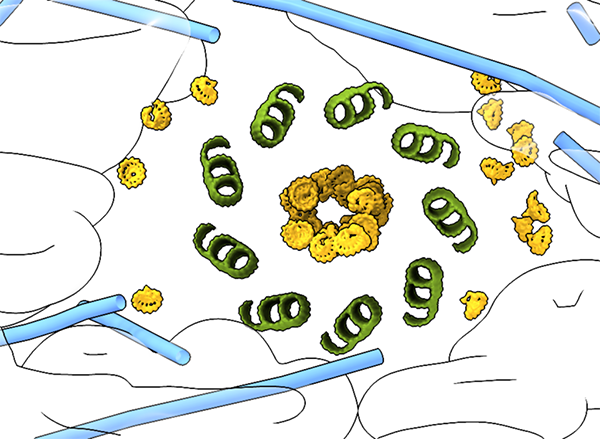Structural Mechanisms for Centrosomal Recruitment and Organization of the Microtubule Nucleator γ-TuRC
| Project Manager | Dr. Stefan Pfeffer |
|---|---|
| Principal Investigator | Dr. Stefan Pfeffer |
| Author of this Article | Dr. Stefan Pfeffer |
| Affiliation | University of Heidelberg, Zentrum für Molekulare Biologie der Universität Heidelberg (ZMBH) |
| Project duration | 9/2022 - 9/2025 |
| Platform used | bwForCluster Helix, SDS@hd |
| bwHPC Domain | Structural and Systems Biology |
| DOI of Publication | 10.1038/s41467-025-57729-2 |
| Project added | 01.10.2025 |
Microtubules have essential functions in diverse cellular processes, such as chromosome segregation during mitosis and meiosis, cell organization and intracellular transport. Their dynamics, number and orientation in the cell are regulated by the γ-tubulin ring complex (γ-TuRC), which drives the assembly of microtubules by providing binding sites for α/β-tubulin subunits during the initial stages of the nucleation reaction. This process is highly regulated by γ-TuRC interactors that impact the microtubule nucleation activity of the γ-TuRC or drive its localization to various microtubule organization centers, most prominently the centrosome.
Using an integrative approach combining cryo-EM methods, AlphaFold-based structure prediction and advanced light microscopy with functional experiments, we here dissected how γ-TuRC targeting and activation factors act in concert to control microtubule nucleation at the structural level. We elucidated the cryo-EM structure and binding site of the γ-TuRC targeting factor NEDD1, which is required for centrosome localization of γ-TuRCs. A complex network of interactions rigidly docks NEDD1 on the γ-TuRC surface and explains the role of NEDD1 in γ-TuRC targeting from a structural perspective. After localization to the centrosome, the microtubule nucleation activity of γ-TuRCs is regulated by the γ-TuRC receptor protein CDK5RAP2. Using cryo-electron tomography to image γ-TuRCs in native centrosomes, we visualized how multiple copies of CDK5RAP2 interact simultaneously with the γ-TuRC to modulate its conformation, with direct consequences on its function as a microtubule template. The same approach also enabled mapping of γ-TuRCs at the centrosome at single molecule precision and revealed a highly structured organization of γ-TuRCs in two separate pools that likely fulfil distinct functions in microtubule organization.
Cryo-EM assumed a central role in this study. A single cryo-EM experiment often generates several Terabytes of data and extensive alignment, classification and averaging of several hundred thousand particle images is computationally highly demanding. The computational resources provided by the bwForCluster Helix and its seamless integration with the data storage service SDS@hd were absolutely instrumental for our study.

